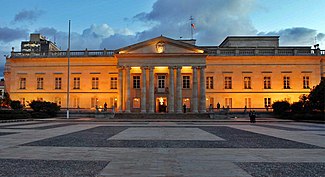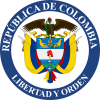President of Colombia
| President of the Republic of Colombia | |
|---|---|
| Presidente de la República de Colombia | |
Constitution of Colombia | |
| Formation | 17 December 1819 |
| First holder | Simón Bolívar |
| Salary | Colombian pesos 32,624,000/US$ 6,847 monthly[1] |
| Website | presidencia.gov.co |
| This article is part of a series on the |
| Politics of Colombia |
|---|
 |
The President of Colombia (President of the Republic) is the
The power of the presidency has grown substantially since the first president, Simón Bolívar, took office in 1819. While presidential power has waxed and waned over time, the presidency has played an increasingly important role in Colombian political life since the early 20th century, with a notable expansion during the presidency of Álvaro Uribe.
The office of president was established upon the ratification of the Constitution of 1819, by the Congress of Angostura, convened in December 1819, when Colombia was the "Gran Colombia". The first president, General Simón Bolívar,[2] took office in 1819. His position, initially self-proclaimed, was subsequently ratified by Congress.
The president is directly elected through Universal Suffrage for a period of four years, along with the
Executive powers
Commander-in-chief
One of the most important executive powers is the role of the president as
Administrative powers
The
The National Government is formed by the President of the Republic, the ministers of the office and the directors of administrative departments. The President and the corresponding Minister or Director of the Department, in each particular business, constitute the Government.[5]
Judicial powers
The responsibility of judging the president of the republic is found in the Supreme Court of Justice, the main body in the event that the president is taken to Political Trial, within the actions of the Supreme Court there will be 7 of which are, Judge the President of the Republic or whoever acts in his place and the senior officials referred to in article 174, for any punishable act imputed to them, in accordance with article 175 numerals 2 and 3.[6]
Foreign affairs
it requires the president to "receive the ambassadors." This clause, known as the Reception Clause, has been interpreted to imply that the president possesses broad power over matters of foreign policy, and endorses the exclusive
While foreign affairs have always been an important element of presidential responsibilities, technological advances since the adoption of the
Leadership roles
As head of state, the president is the visible face of Colombia's domesitc and foreign policy. In his role as leader, one of his aspects is to represent and safeguard the international image of the country, since 1934, the year in which it was officially created, it is the protocol office of the First Lady, she is the one who is in charge of accompanying the president at his receptions. and state visits abroad, gaining more importance over time.[8]
The president of Colombia symbolizes the National Unity, and after taking an oath to the
The
Article 115 states that the
Any act by the president of Colombia, in order to be legal and enforceable, must be sanctioned by any of the
Selection process
Eligibility
The president must be a
- be a natural-born citizen
- be a at least 30 years old
Campaigns and nomination
The modern presidential campaign begins before primary elections, which political parties use to clear the field of candidates before their national nominating conventions, where the most successful candidate is the party's or coalition's presidential candidate. In general, the presidential candidate of the party or, failing that, the coalition of parties chooses a candidate for the vice-presidency, generally being the second with the highest number of votes in the convention. The most common previous profession of presidents is that of a lawyer.
Election
The president and vice president serve a term of office of four years after being elected by popular vote. Since 2015, the president is barred from running for reelection, even for a nonconsecutive term.[12]
From 1910 to 2005, the president was limited to a single term. However, on 24 November 2005, the
Inauguration
The inauguration of the President is made up of various ceremonies and traditions carried out on August 7 every four years.[15] Through democratic elections or coups, resignations and deaths, presidential inaugurations[16] have been important events in the history of Colombia, which at the same time mark the beginning of new eras.[17][18]
Presidential sash
The presidential sash is considered
Incumbency
Residence

Currently the
The House of Illustrious Guests in the city of
Travel

When traveling within Colombia or abroad, the President of the Republic uses the presidential plane identified with the registration
Protection

On December 7, 1927, President
Since August 16, 1928, the security of the president has been in the hands of the
References
- ^ "¿Sabe usted cuánto gana el presidente de Colombia?". El Universal. 30 May 2015.
- ^ Gobernantes Colombianos, Ignacio Arismendi Posada, Interprint Editors Ltd., Italgraf, Segunda Edición, Page 15, Bogotá, Colombia, 1983
- Constitution of Colombia. 7 August 1991. Retrieved 17 April 2023.
- ^ Jáuregui Sarmiento, David (27 April 2022). "¿Por qué el Presidente es el jefe de las Fuerzas Armadas?". señalcolombia.tv. Retrieved 14 April 2023.
- ^ "Rama Ejecutiva del Orden Nacional". funcionpublica.gov.co. 7 March 2023. Retrieved 17 April 2023.
- Constitution of Colombia. 7 August 1991. Retrieved 17 April 2023.
- Constitution of Colombia. 20 July 1991. Retrieved 17 April 2023.
- ^ "Rama Ejecutiva del Orden Nacional". funcionpublica.gov.co. 20 July 2023. Retrieved 26 April 2023.
- ^ a b "Departamento Administrativo de la Presidencia de la República : Nuestra Entidad" (in Spanish).
- ^ "Requisitos para ser candidato presidencial". pdba.georgetown.edu. 14 March 2017. Retrieved 27 February 2023.
- ^ "Reseña Histórica". cne.gov.co. 8 August 2020. Retrieved 27 February 2023.
- ^ L, Elizabeth Reyes (4 June 2015). "Colombian lawmakers approve a one-term limit for presidents". EL PAÍS English Edition.
- ISBN 978-1-935264-12-5.
- ^ "Constitución Política de 1991 (Artículo 197)". Secretaría General del Senado.
- ^ "Las razones por las que la ceremonia es el día de la Batalla de Boyacá y no en otra fiesta patria". eltiempo.com. 15 June 2022. Retrieved 4 December 2022.
- ^ "Así viví la posesión presidencial, un día histórico detrás de cámaras". rcnradio.com. 12 August 2022. Retrieved 11 November 2022.
- ^ "Gustavo Petro viajará a la Sierra Nevada de Santa Marta antes de posesionarse". rcanradio.com. 4 August 2022. Retrieved 11 November 2022.
- ^ "Más allá de una batalla, los actos presidenciales del 7 de agosto". señalmemoria.co. 7 August 2022. Retrieved 17 August 2022.
- ^ "La Casa de Nariño". wsp.presidencia.gov.co. Presidencia de la República de Colombia. Retrieved 14 February 2012.
- ^ "Bicentenario en Bogotá 1810-2010" (PDF). Alcaldía Mayor de Bogotá. p. 95-97. Archived from the original (PDF) on 16 March 2014. Retrieved 14 February 2012.
- ^ "Bogotá y sus palacios". Secretaría de Cultura y Turismo. Archived from the original on 16 July 2012. Retrieved 14 February 2012.
- ^ "Reseña histórica de la Casa de Nariño". Presidencia de la República. Retrieved 30 January 2011.
- ^ "Sedes de gobierno". Universidad de Los Andes. Archived from the original on 7 February 2012. Retrieved 14 February 2012.
- ^ Casa de Huéspedes Ilustres de Cartagena
- ^ "Historia de la Hacienda Hatogrande". El Tiempo. Retrieved 10 March 2012.
- ^ "Comandante de la Fuerza Aérea Colombiana Asiste a la Celebración de los 100 años del Periódico "El Colombiano"". Fuerza Aérea Colombiana. Retrieved 15 June 2012.
- ^ a b "::SP NOTICIAS - Presidencia de la República de Colombia::". web.presidencia.gov.co. Archived from the original on 17 December 2011. Retrieved 13 January 2022.
- ^ "Página No Encontrada". Ejército Nacional de Colombia (in Spanish). Archived from the original on 28 November 2022. Retrieved 28 November 2022.

